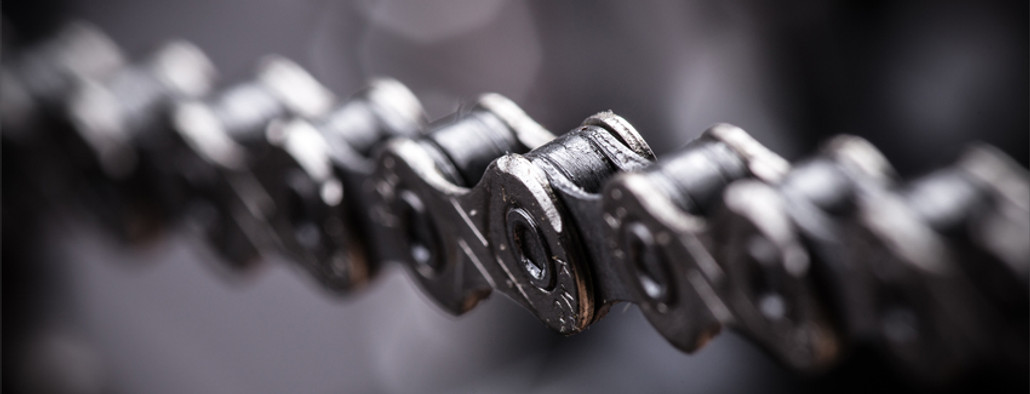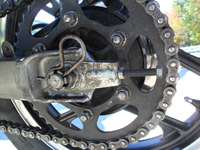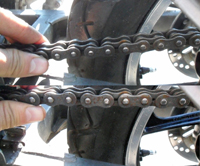How To Lubricate and Adjust Your Drive Chain
Posted by Team Motorcycle on Jul 19th 2016
|
|
|
|
|
|
|
When compared to larger vehicles like cars, motorcycles are considerably simpler machines. In trade they tend to require considerably more maintenance to keep operating optimally. While the concept of manually lubricating and adjusting a drive chain may seem alien to someone who's only driven four-wheeled vehicles their entire life, it's the most frequent procedure that a motorcyclist will have to perform on their bike. Luckily the tasks are actually quite easy to perform and as a side benefit give you a great opportunity to do a quick safety inspection of the rear end. |
|
|||
|
|
|
|
|
|
| With some exceptions such has Harley-Davidson models, most motorcycles use a heavy-duty chain that operates very similarly to a bicycle chain. On each link of the chain there are "rollers" which reduce friction and wear. These rollers are packed with grease and sealed with rubber gaskets called "o-rings. While these modern chain features do an excellent job of extending their mileage they are not immune from wear and will stretch over time. The rear axles on motorcycles can be adjusted backwards to increase tension on a stretching chain, and this essentially is the chain adjustment procedure. Lubrication of the chain primarily serves to keep the o-rings in good condition and prevent drying of the rubber, but also to prevent rust for accumulating. | ||||
|
|
|
|
|
|
|
|
|
Chain lubrication should be done roughly every other gas tank. If you ride in the rain it should be done more frequently. Actual adjustment of the chain only needs to be done when the chain exceeds the limits outlined by the manufacturer. A general guide for road bikes is 1.5-2.5 inches of free play but the numbers can vary based on many factors so be sure to check your manual first. | ||
|
|
|
|
|
|
| To lubricate your chain, raise the rear tire off of the ground and put the bike in neutral. You can freely spin the wheel and work from one spot on the chain. There are many lubricating agents that are effective and what you choose ultimately comes down to personal preference. Some people like to use a viscous motor oil, while others prefer to use something thinner like transmission fluid. There are of course many products that are specifically made for lubricating chains as well, ranging from aerosols to waxes and much more. Each have their own benefits and compromises, so experiment and do some research to find what suits you best. You may want to have |
|
|||
| some old rags handy to prevent overspray or help you apply lubricant. Masking areas that you don't want to get greasy is a good idea too. | ||||
|
|
|
|
|
|
| Adjustment of the chain to bring it back into the recommended tolerances is in concept the same for all chain-driven motorcycles. A bolt on each side of the swingarm is turned in small and equal increments to symmetrically move the axle rearward until the chain is tightened to within the manufacturer's free-play specifications. Most adjustment setups include lock-nuts or a similar locking mechanism to prevent the bolts from turning during riding. Check your chain's free play every time you lubricate your chain, and adjust as necessary. Keeping your chain properly lubricated and adjusted will go a long way towards ensuring that it lasts as long as possible. | ||||
|
|
|
|
|
|
|
|
|
As previously noted, there are alternatives to a drive chain to transmit power to the rear wheel. Many modern cruisers use a self-tensioning belt and pulley system that requires no lubrication, similar to a serpentine belt on an automobile. If you have this drive system on your motorcycle, it should be regularly inspected for wear. Cracking, fraying, discoloration, slipping, or missing belt teeth are all potential signs of failure. Replace damaged belts as needed. Another popular option is shaft-drive, common on touring motorcycles designed for racking up big miles. This is a relatively low-maintenance |
||
| configuration but gear oil will need replacing at certain mileage intervals. There may be other types of preventative maintenance depending on the design to be sure to refer to the manufacturer's instructions. Looks for torn dust seals and leaking gear oil. It's wise to check the gear oil level occasionally too. If the gears run dry they can overheat and become damaged quite quickly. | ||||
|
|
|
|
|
|
| While not as common I felt it was worth mentioning the other drive types to get people pointed in the right direction. Whichever the case may be, if you want to enjoy many thousands of trouble-free miles on your motorcycle you should show your final drive the attention and respect it deserves. Be safe and keep those wheels rolling! | ||||
|
|
|
|
|
|





